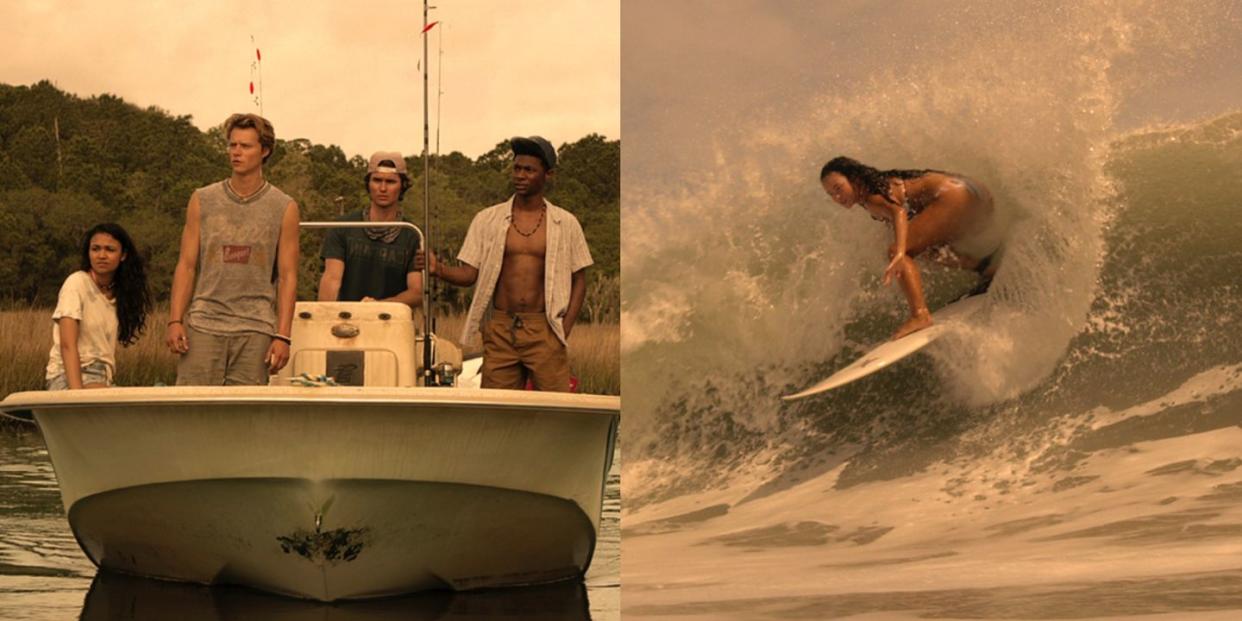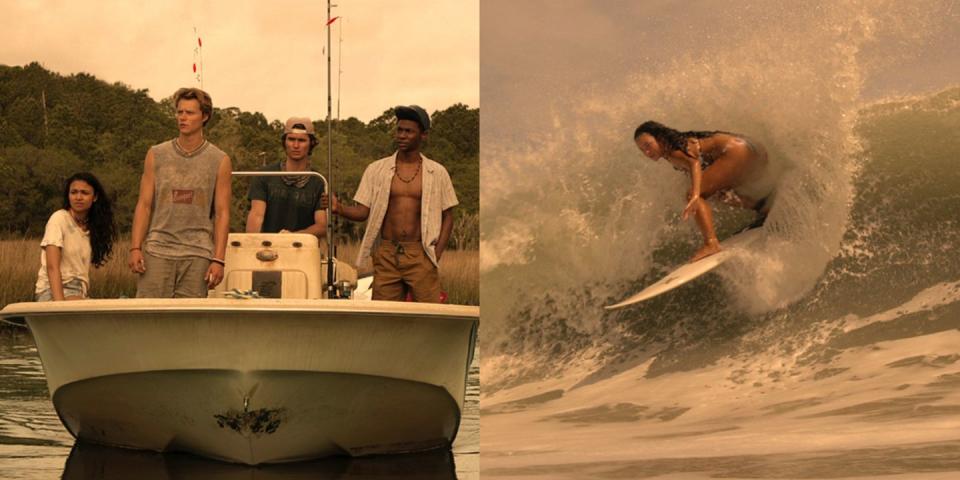A Real Outer Banks Surfer on Pogues, Kooks, and What the Netflix Show Gets Wrong

Despite the ships mysteriously vanishing at sea, and the hunt for a lost treasure, and an entire community full of unusually attractive people, there's something that feels real about Netflix's Outer Banks. Perhaps this is because it's set in the very real stretch of islands off the coast of North Carolina, or because its creators are from the area, or because of the lived-in atmosphere of the show. And, to many of the millions binging the show (it has been consistently on Netflix's top 10 most popular list since its debut on April 15), this is probably the most exposure they've had to the real Outer Banks.
The show follows some teens from the wrong side of the ... uh ... marsh, as they embark on a dangerous hunt for a storied lost treasure. It's fun, and certainly a welcome way to pass the time in quarantine. But while streaming the first few episodes I found myself curious about the real Outer Banks culture. In the show, it's depicted as a community with a big divide between the upper and lower class, where teens spend their days joyriding on boats and drinking beer and following treasure maps. Its protagonist is John B. (Chase Stokes), the heartthrob ringleader of a group of kids from the less-affluent side of town who call themselves Pogues. They're in a bitter rivalry with the rich kids in town, who are known as Kooks. The show is as much about a stark class divide as much as it is about boats, treasure, teens, and surfing.
Curious to know what the real Outer Banks is like, I called up local surfer Brent Nultemeier, who co-owns, OBXsurfinfo.com, a popular website that follows the local surf report and culture ("If you can’t get to the beach then we can bring the beach to you," Nultemeier tells me). A lifelong surfer, Nultemeier was out on the ocean the morning we talked. With the bridges to Outer Banks closed to anyone but locals during the coronavirus outbreak, the beaches are still open and empty—making it prime surfing time for residents like Nultemeier.
And when they're not enjoying the empty beaches, the Outer Banks locals have been watching Netflix's latest streaming hit along with the rest of the country.
In the weeks before the show debuted, Nultemeier says the locals were excited to see their town on a big Netflix show. But, when it finally premiered, some were disappointed.
"It's just Hollywood to me. It's all make-believe. People need to get over it," he tells me. "But there's a lot of very headstrong locals here that, I guess they were excited to see a mainstream Netflix show that was potentially going to show how amazing this area is, because we're all very, very proud of living here. And then the show portrays a completely different area. It should have been called South Carolina Beaches or something. It's almost like, 'oh well, why even name it that?' I guess that's the big hangup that people have."
Pogues and Kooks
In Outer Banks John B. and his friends refer to themselves as the Pogues. "This is the south side, or the cut," he explains in the first episode, as it shows a more rundown part of town. "Home of the working class, who make a living busing tables, washing yachts, running charters. The natural habitat of the Pogues." It's a name that he says comes from the term pogies, slang for the Menhaden fish. While John B. often refers to he and his friends as Pogues, the term is also used around town as a catchall for people from his side of the marsh (it's confusing). Meanwhile, rich people are called Kooks, which is a repurposed use of an old surfing term.
As Nultemeier tells me, the term "Pogue" isn't anything people in the Outer Banks use. "That's a full on Hollywood thing," he says. And obviously, the word kook is old surfing slang, but it's not used specifically to refer to rich people in the Outer Banks.
"Usually a kook is somebody that doesn't know what they're doing, who bought a surfboard and wants to portray this image of being a surfer when they're entirely not. That to me is more of a definition of a kook than anything else," he tells me. "But over the years, I'm sure that term has been widely used elsewhere. I mean, anybody could be a kook at this point."
The Class Divide
The through-line of the show is this struggle between the "haves" and the "have nots" in the Outer Banks. As Nultemeier describes it, the socio-economics of the Outer Banks aren't as obtuse or overt as the show depicts:
I moved here and started my family here. You have to work a couple of jobs to make it here—it's not super expensive to live here, but it's not cheap either. There's not a lot of low income housing. There are a lot of seasonal employees over the summer who come work in the shops and the stores. I know there's a huge shortage of low income housing, and they're building these mega mansion estates. So, there's obviously lots of money here. There's people building ocean front homes and multimillion dollar places and stuff. I don't know of a giant divide that's clear, as they portray it on the TV show. Let's just put it that way.
A post shared by OBXsurfinfo (@obxsurfinfo) on Apr 21, 2020 at 4:16am PDT
The Setting And Scenery and Filming Location
Outer Banks was not filmed in the actual Outer Banks. The show was originally intended to shoot in North Carolina, but showrunners moved it out of the state in response of the HB2 transgender bathroom bill. Instead, the show was filmed outside of Charleston, South Carolina. As such people in Outer Banks, including Nultemeier, noticed a number of geographical errors, like the show depicting the Pogues taking a ferry to land-locked Chapel Hill. As Nultemeier noticed:
They showcase some kind of a lighthouse that was not even from our area at all. Some of the homes and some of the vegetation is wrong, too. Further South there's a lot more palm trees. We don't have that many palm trees here on the Outer Banks. Some of it looked similar, but when you live here, in the very first episode you're like, "Oh, that's not here."
The Culture
Outer Banks shows a lifestyle where teens cruise around on their boats to visit friends, go to parties, or track down ancient treasure. But, Nultemeier notes that this isn't really the lifestyle in the real Outer Banks:
That's not necessarily how it goes around here. I'm sure there are some communities where you can hop on your boat and get from place to place, you can go to restaurants or something. But I mean, it's so much more expensive to do that than just getting in your car and going somewhere. You don't normally travel around in your boat all the time. Boats aren't cheap.

The Actual Surfing
In the premiere episode, we see John B. and his buddy paddle out into a hurricane to surf some monster waves. But, in reality, very few people would have the skill or the nerves to surf in a hurricane. And, unfortunately, the scene didn't even look that realistic, according to Nultemeier:
It is awful when Hollywood tries to make people look like they're surfing. It is the worst thing ever. I mean, Point Break, I don't know, you name it, any Hollywood movie that tries to show surfing. I mean, hurricane surfing, absolutely that happens. But when it gets really, really big and really gnarly, the only way to do it is with a jet ski. And maybe one or two groups of people might actually attempt to do that, but again, that's very rare.
You Might Also Like

